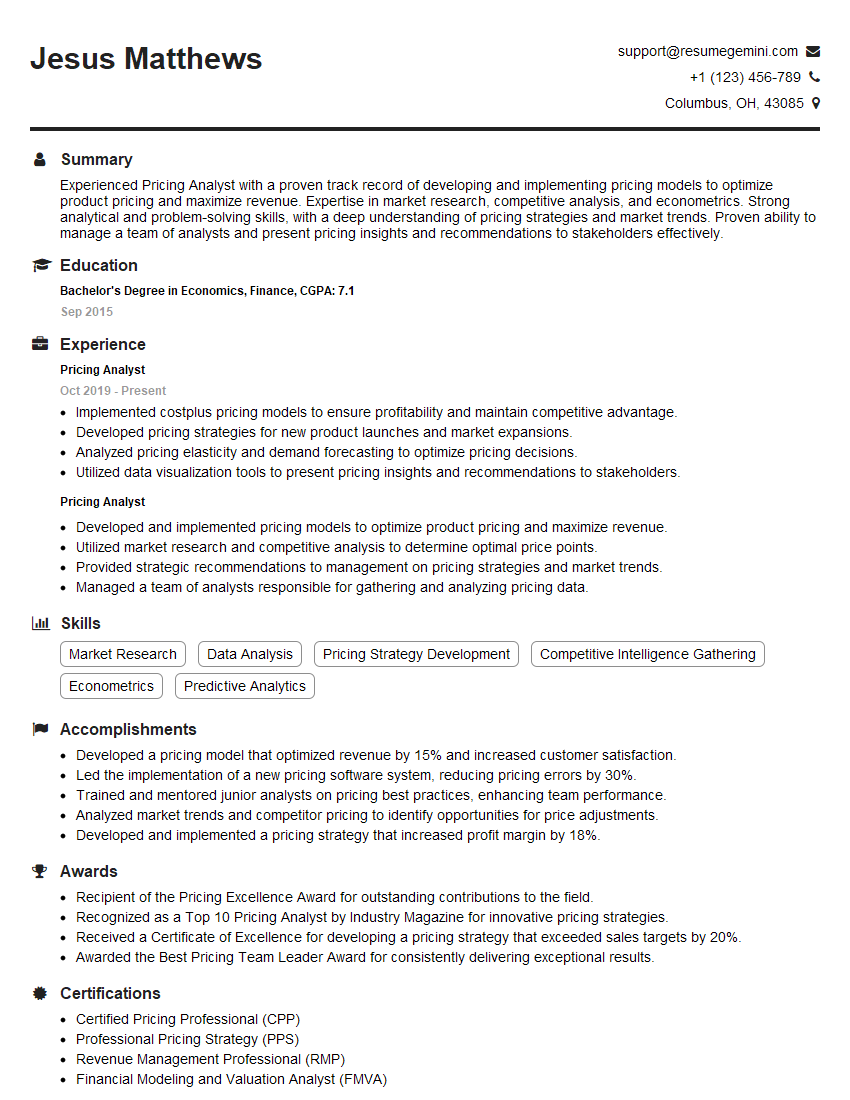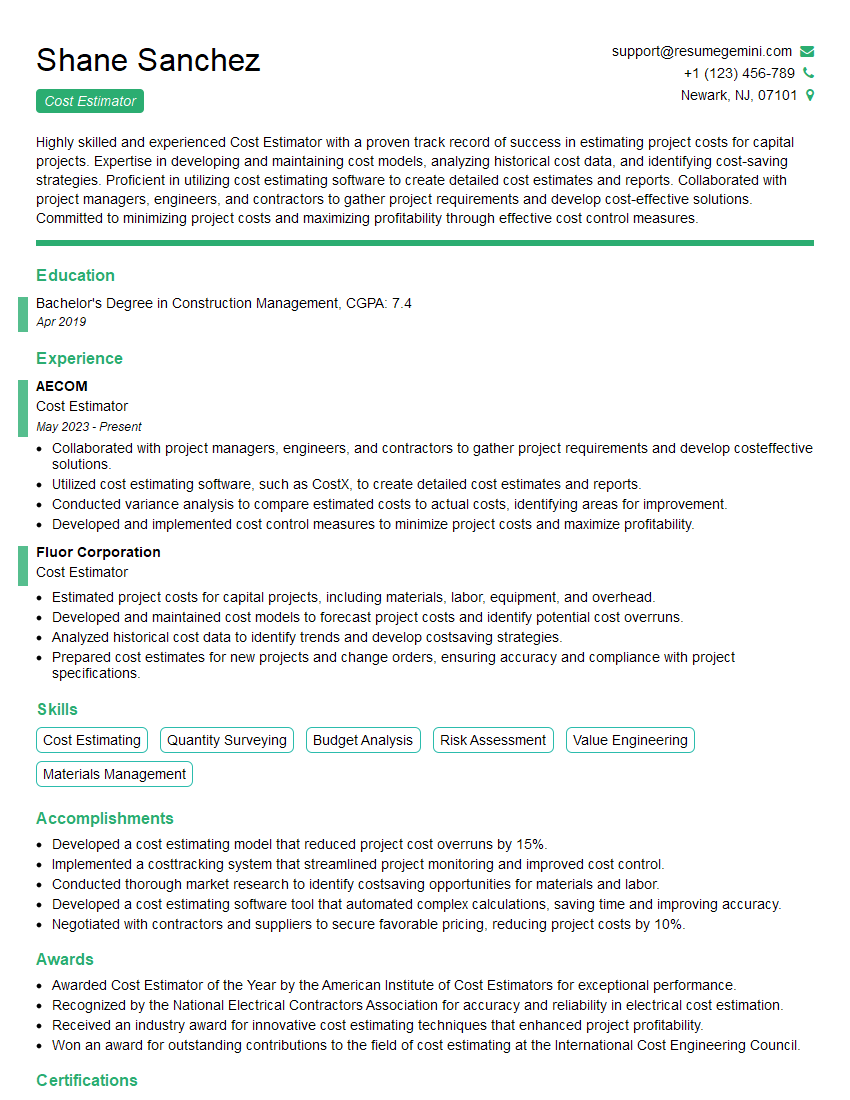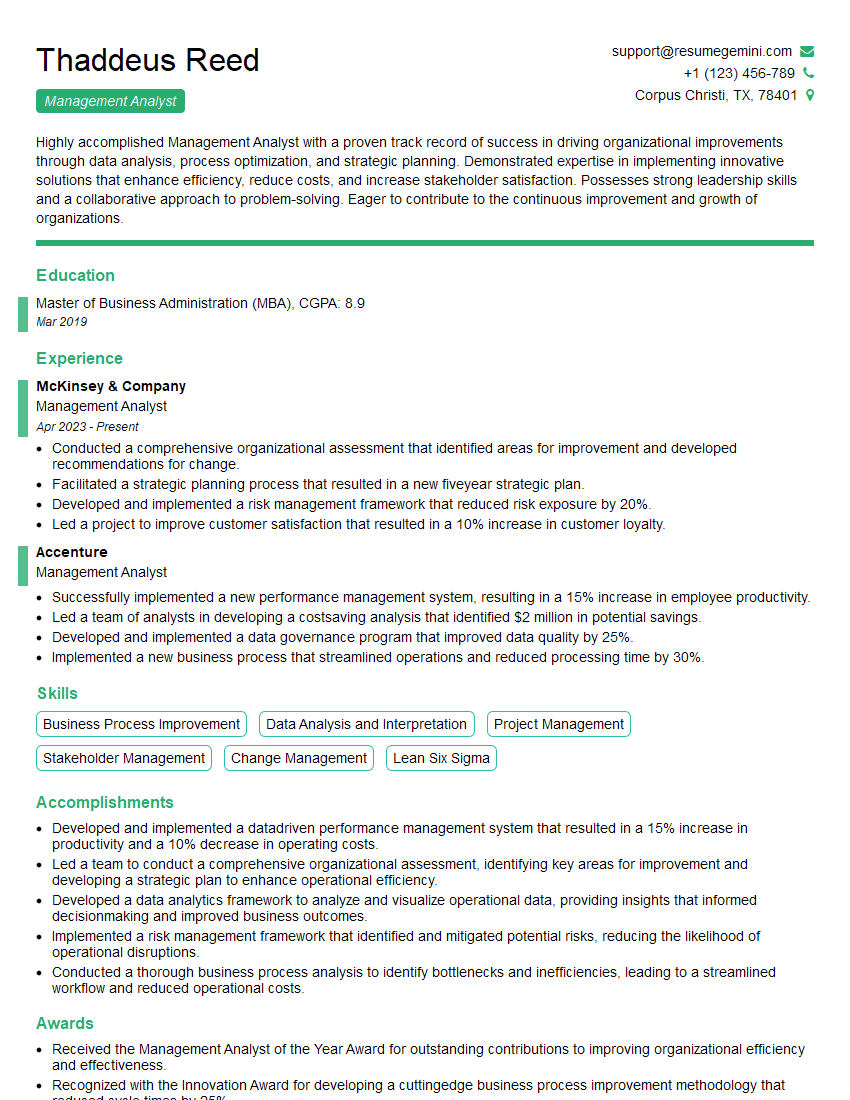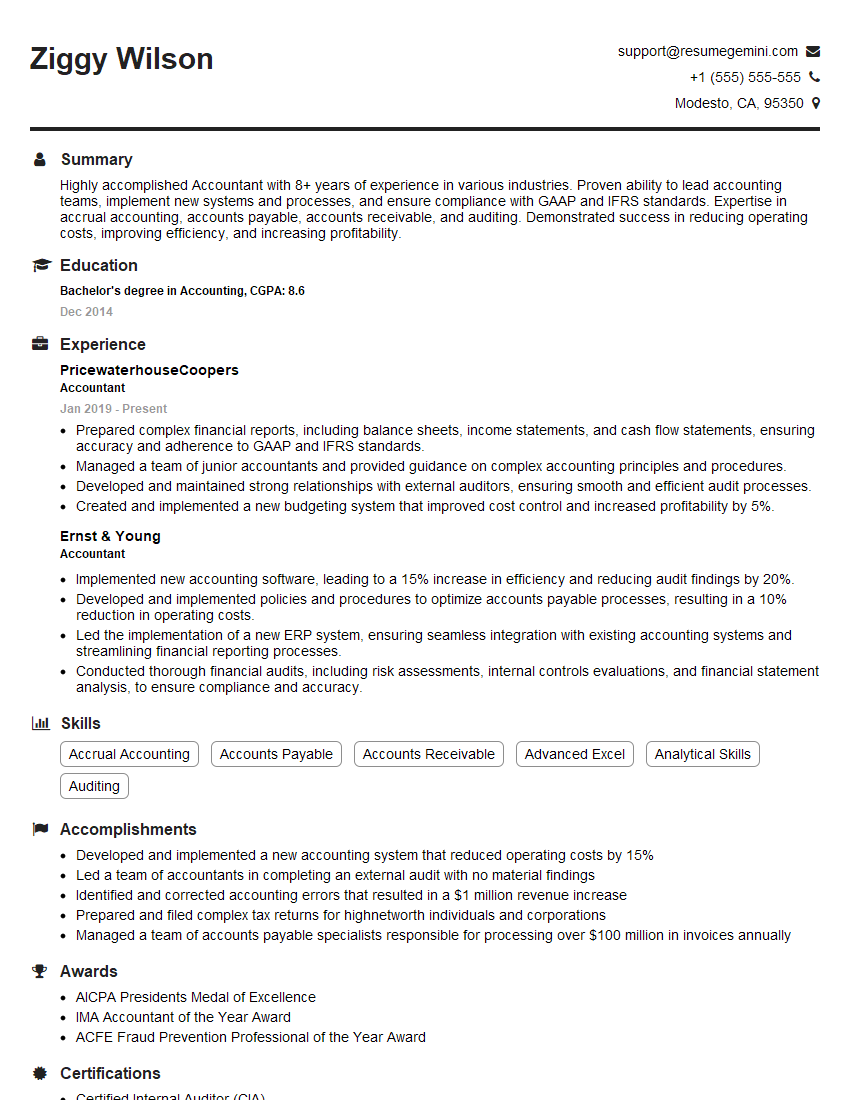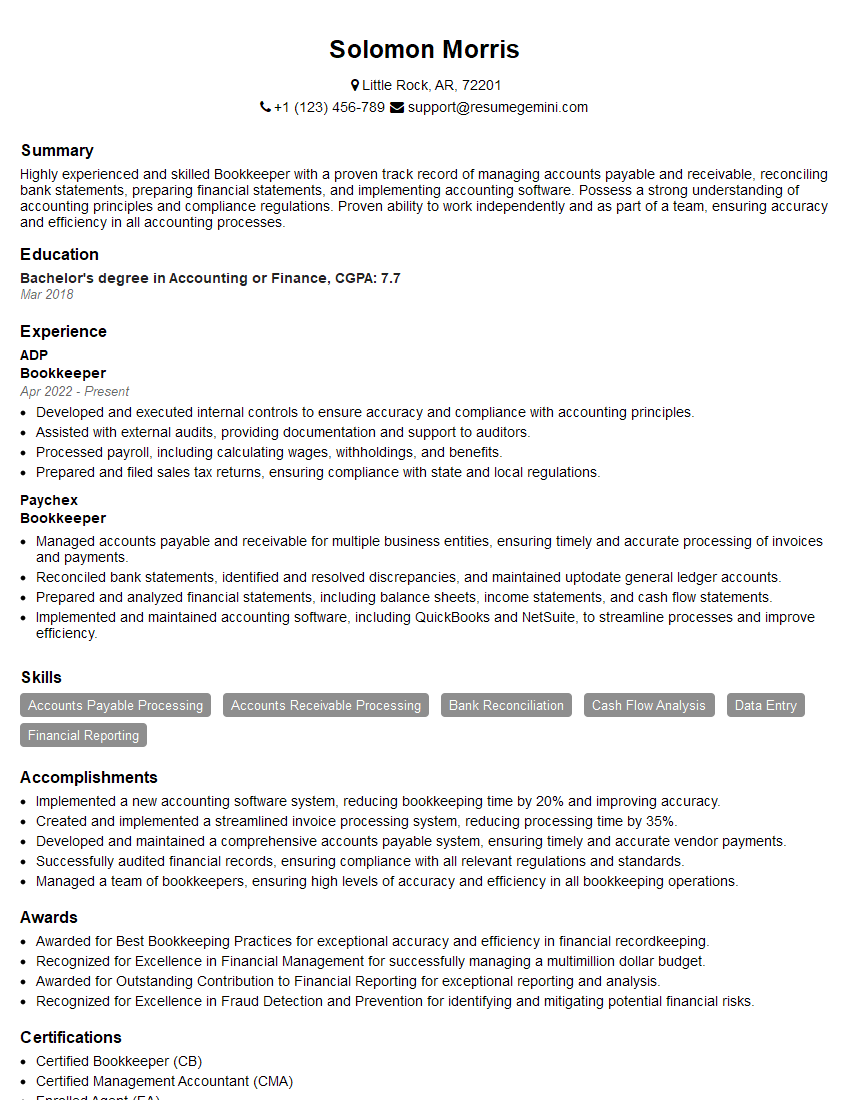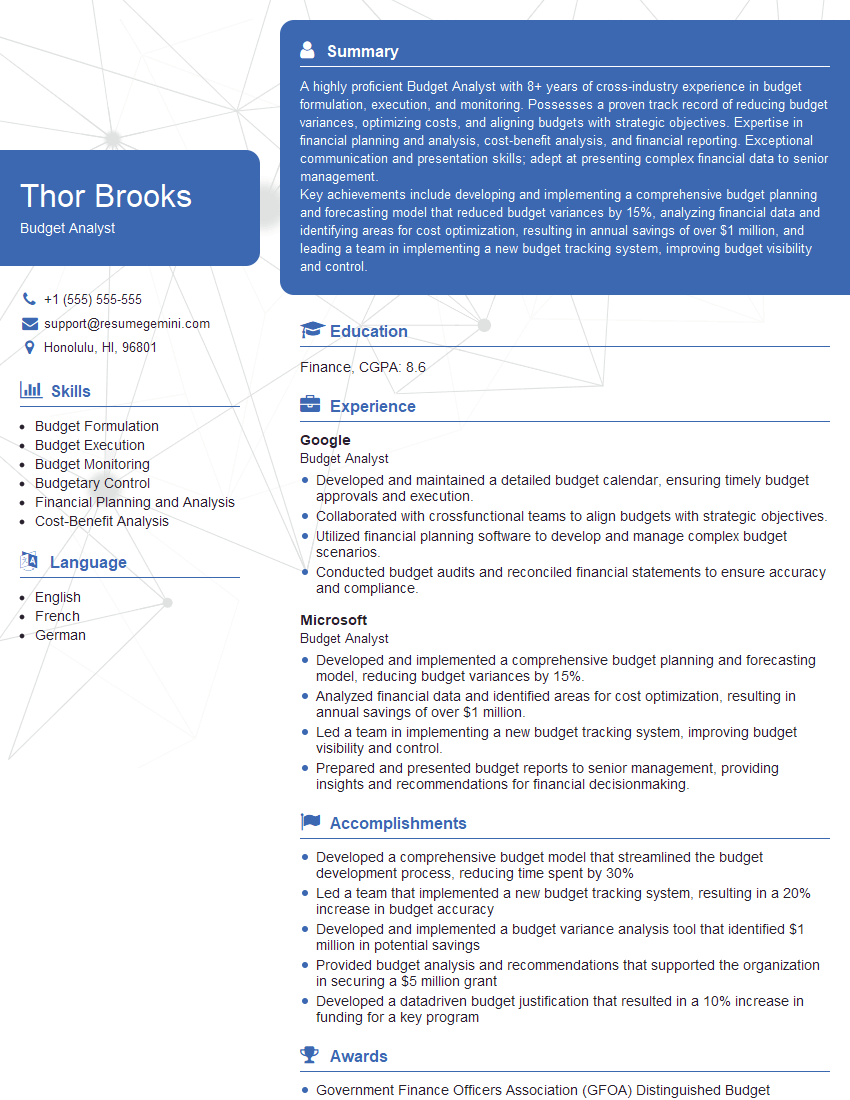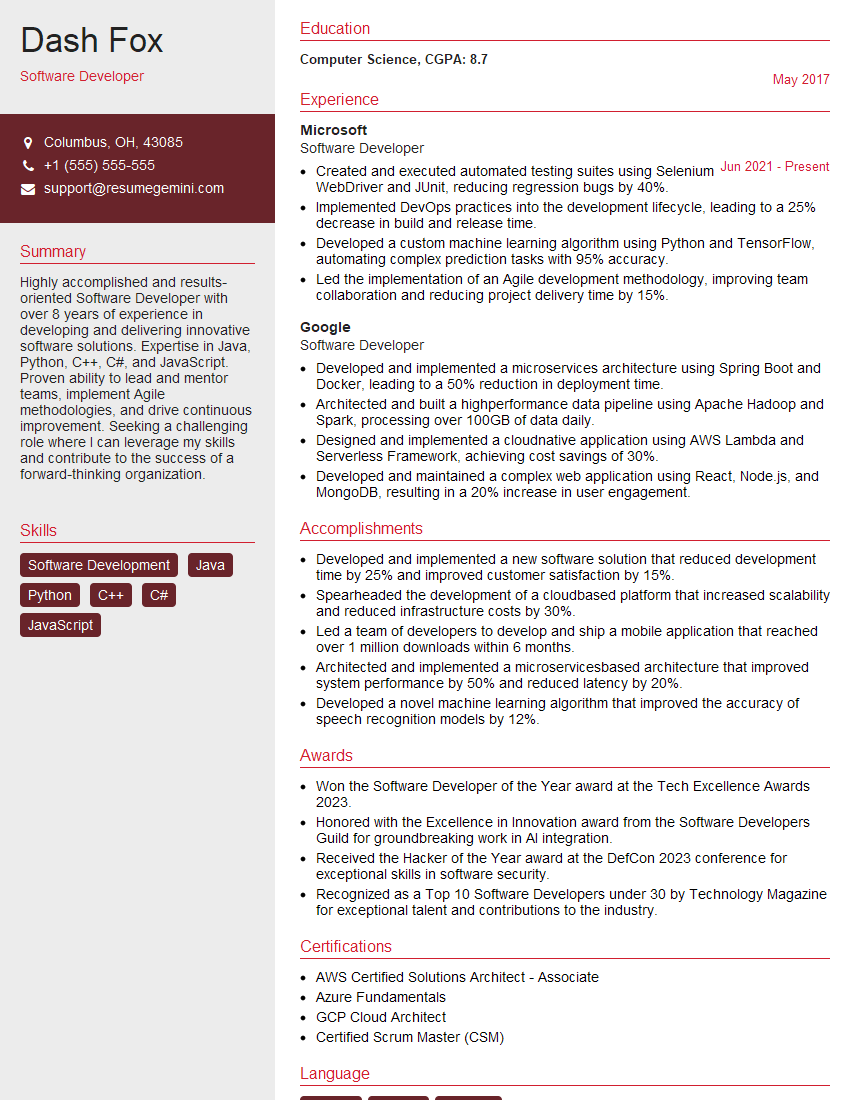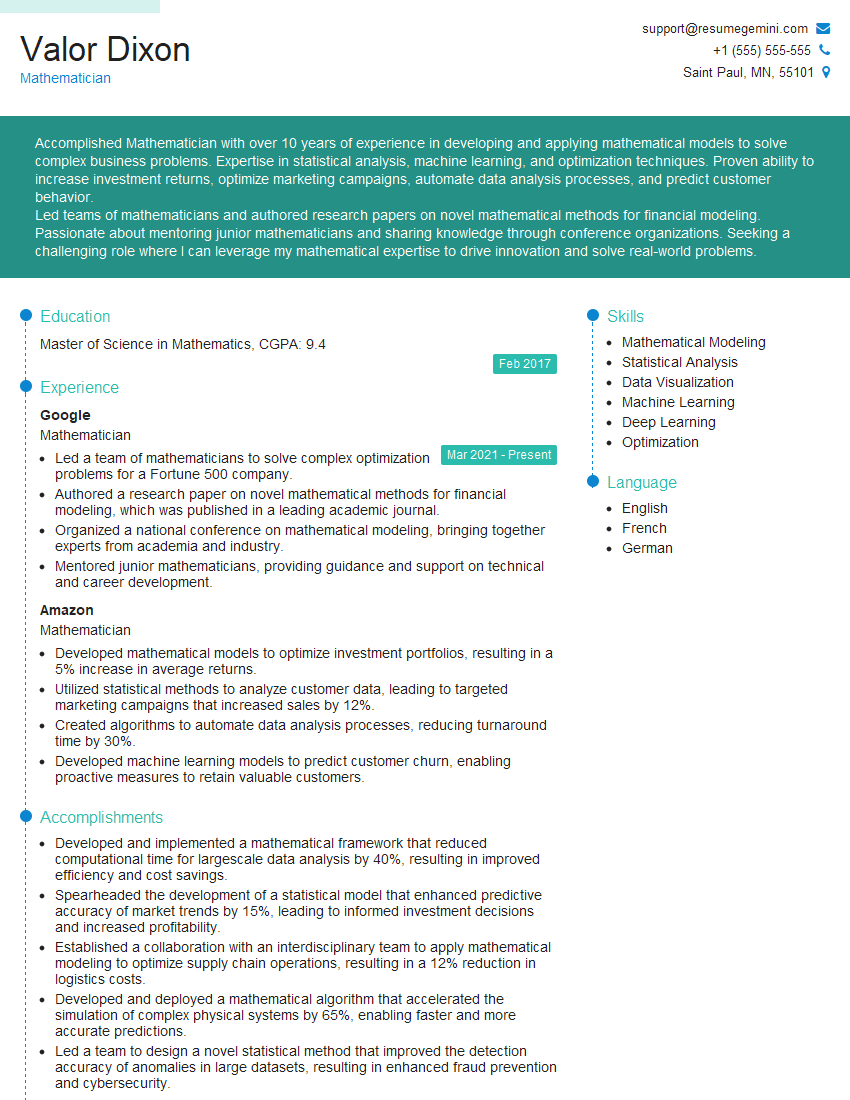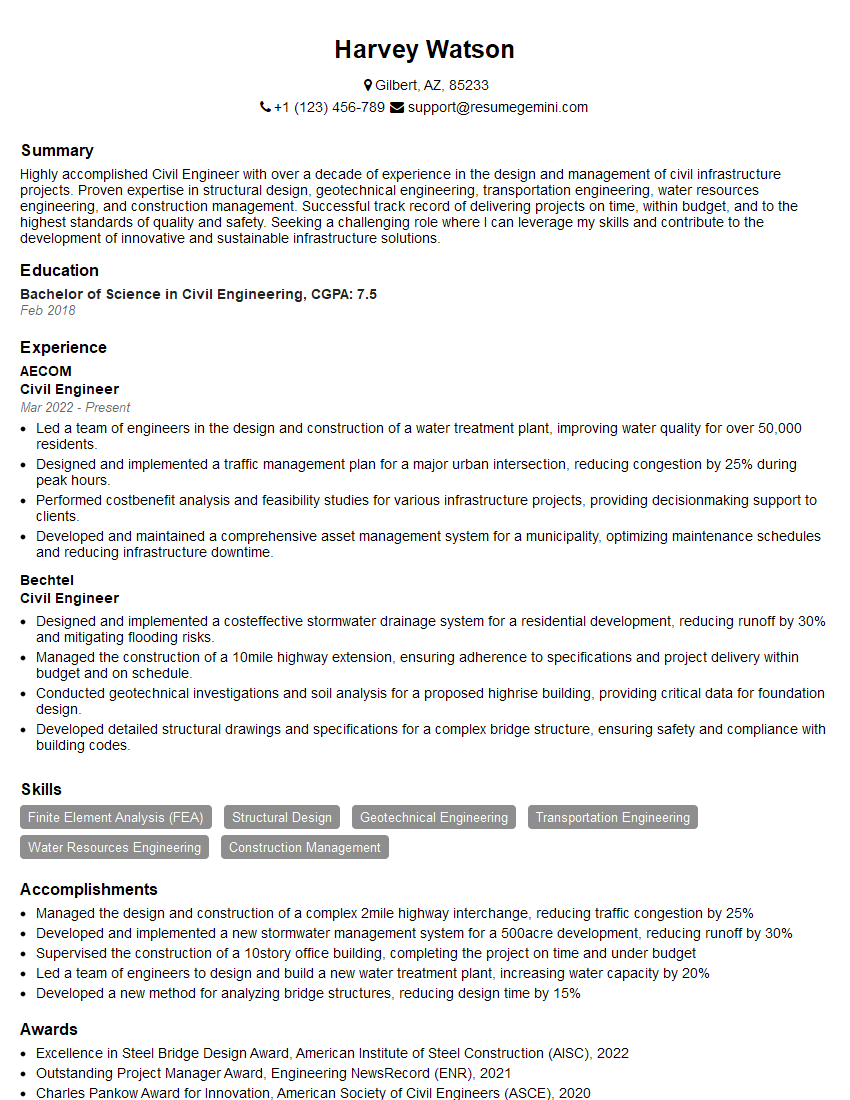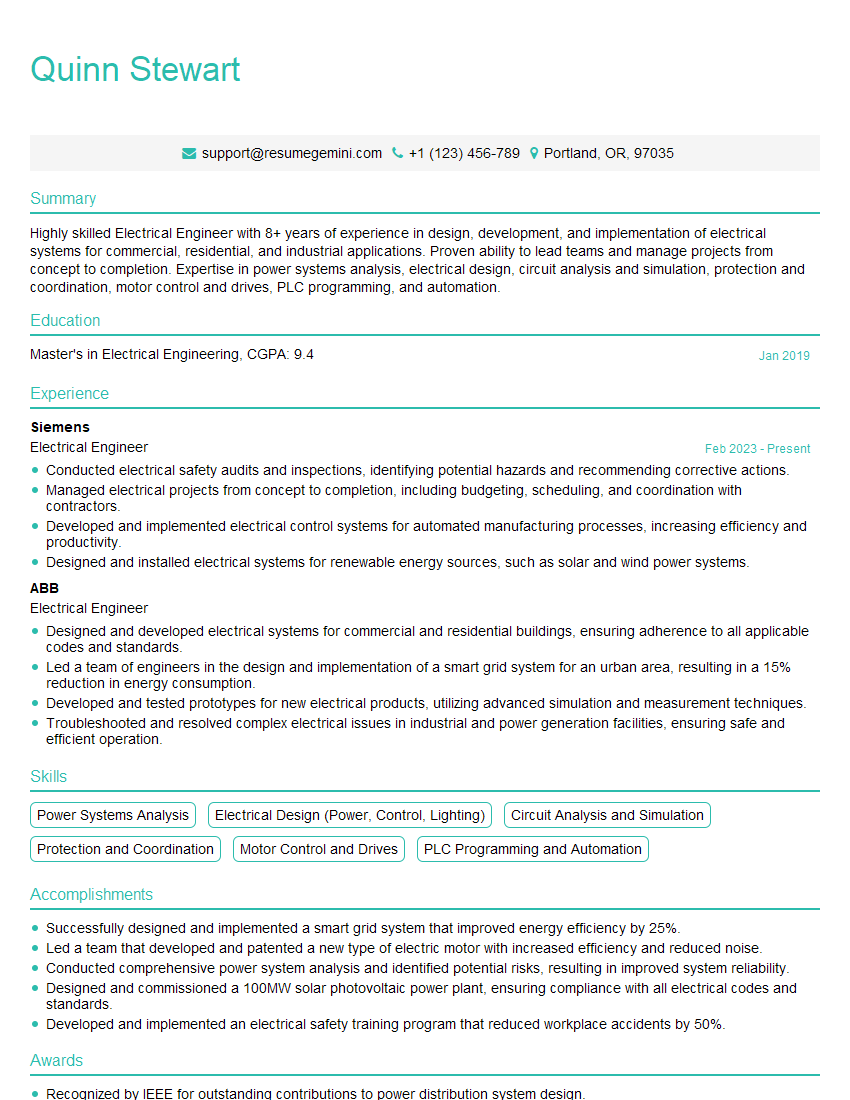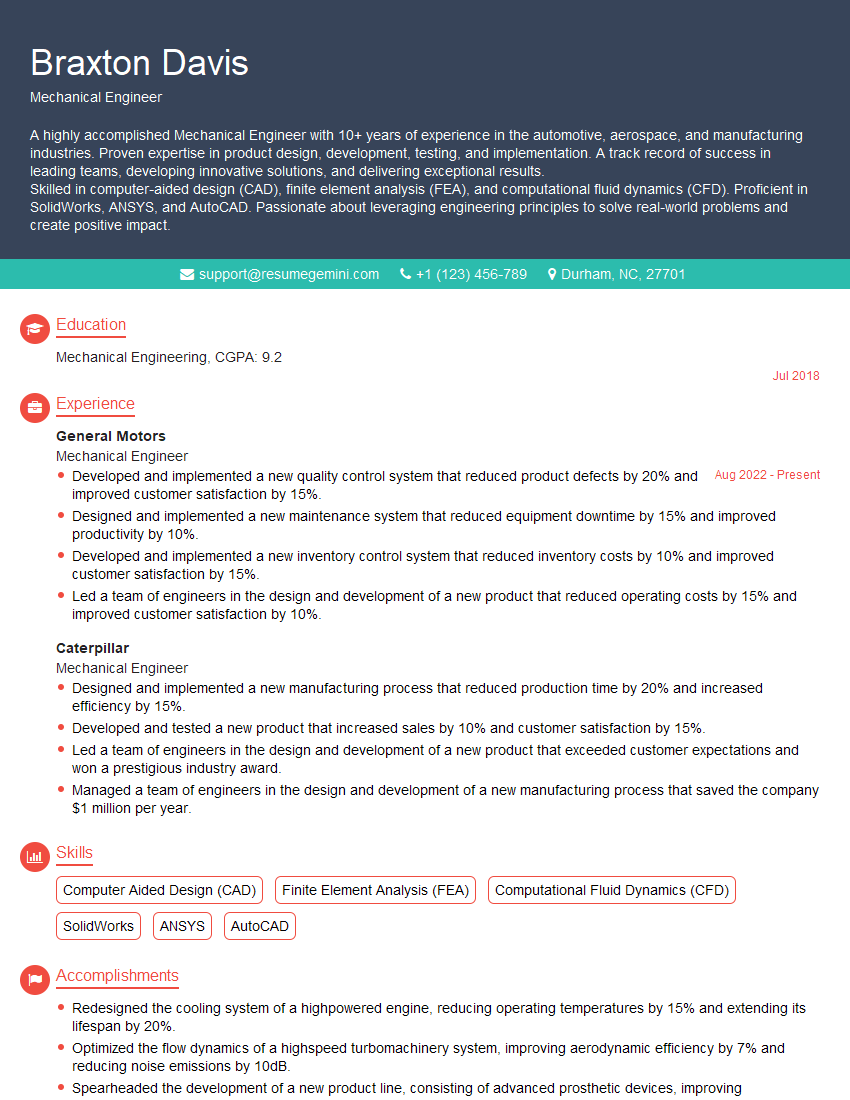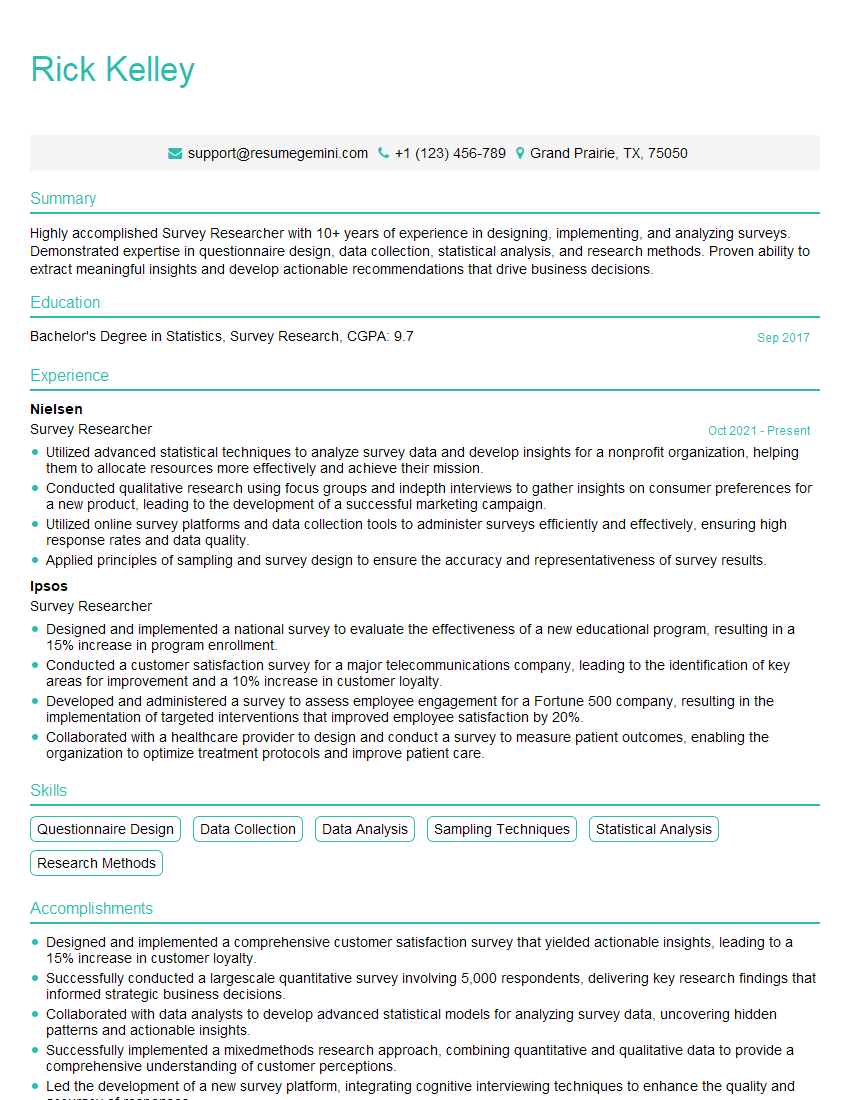Interviews are opportunities to demonstrate your expertise, and this guide is here to help you shine. Explore the essential Proficiency in Basic Math Calculations interview questions that employers frequently ask, paired with strategies for crafting responses that set you apart from the competition.
Questions Asked in Proficiency in Basic Math Calculations Interview
Q 1. What is the result of 35 + 17 – 12?
This problem involves basic arithmetic operations – addition and subtraction. Following the order of operations (PEMDAS/BODMAS), we perform addition and subtraction from left to right.
- First, add 35 and 17: 35 + 17 = 52
- Next, subtract 12 from the result: 52 – 12 = 40
Therefore, the result of 35 + 17 – 12 is 40. This type of calculation is fundamental in many areas, from balancing a checkbook to calculating project budgets.
Q 2. Calculate 25% of 120.
To calculate a percentage of a number, we convert the percentage to a decimal and then multiply it by the number. 25% can be written as 0.25 (or 25/100).
Calculation: 0.25 * 120 = 30
Therefore, 25% of 120 is 30. This is a common calculation used in various applications, such as calculating discounts, sales tax, or tips.
For example, if a store offers a 25% discount on an item priced at $120, the discount amount would be $30.
Q 3. What is the average of 15, 22, and 31?
To find the average (or mean) of a set of numbers, we sum all the numbers and then divide by the total count of numbers.
- Sum of the numbers: 15 + 22 + 31 = 68
- Total count of numbers: 3
- Average: 68 / 3 = 22.666… (approximately 22.67)
Therefore, the average of 15, 22, and 31 is approximately 22.67. Averages are frequently used to represent central tendencies in data sets, for instance, calculating the average score on a test or the average monthly rainfall.
Q 4. Solve for x: 2x + 5 = 11
This is a simple algebraic equation. We need to isolate ‘x’ to solve for its value.
- Subtract 5 from both sides of the equation: 2x + 5 – 5 = 11 – 5 This simplifies to 2x = 6
- Divide both sides by 2: 2x / 2 = 6 / 2 This gives us x = 3
Therefore, the solution to the equation 2x + 5 = 11 is x = 3. Solving algebraic equations is essential in various fields, including physics, engineering, and finance, for modeling and problem-solving.
Q 5. What is the area of a rectangle with a length of 10 cm and a width of 5 cm?
The area of a rectangle is calculated by multiplying its length and width.
Area = Length × Width
In this case, Length = 10 cm and Width = 5 cm.
Area = 10 cm × 5 cm = 50 cm²
Therefore, the area of the rectangle is 50 square centimeters. Calculating areas is crucial in various applications, such as determining the amount of carpet needed for a room or the size of a building lot.
Q 6. What is the perimeter of a square with sides of 7 cm each?
The perimeter of a square is the total distance around its four sides. Since all sides of a square are equal, we can calculate the perimeter by multiplying the length of one side by 4.
Perimeter = 4 × side length
In this case, the side length is 7 cm.
Perimeter = 4 × 7 cm = 28 cm
Therefore, the perimeter of the square is 28 centimeters. Perimeter calculations have applications in various fields, such as fencing a yard or determining the frame size for a picture.
Q 7. What is 15 divided by 3?
Division is the process of splitting a number into equal parts. In this case, we need to find out how many times 3 goes into 15.
15 / 3 = 5
Therefore, 15 divided by 3 is 5. Division is a fundamental operation used extensively in various calculations, from splitting costs equally among individuals to calculating unit prices.
Q 8. What is 12 multiplied by 6?
Multiplication is a fundamental arithmetic operation that involves repeated addition. To calculate 12 multiplied by 6 (12 x 6), we can think of it as adding 12 six times: 12 + 12 + 12 + 12 + 12 + 12. Alternatively, we can use the standard multiplication method, which is faster for larger numbers.
Step-by-step calculation:
- Multiply 6 by the ones digit of 12 (6 x 2 = 12). Write down ‘2’ and carry-over ‘1’.
- Multiply 6 by the tens digit of 12 (6 x 1 = 6). Add the carry-over ‘1’ (6 + 1 = 7).
- The result is 72.
Therefore, 12 multiplied by 6 equals 72. This is a frequently used calculation in everyday life, from calculating the cost of multiple items to determining the area of a rectangle.
Q 9. Convert the fraction 3/4 to a decimal.
Converting a fraction to a decimal involves dividing the numerator (the top number) by the denominator (the bottom number). In the case of 3/4, we divide 3 by 4.
Step-by-step calculation:
- Perform the division: 3 ÷ 4 = 0.75
Therefore, the fraction 3/4 is equal to the decimal 0.75. This conversion is crucial in various fields such as finance (calculating percentages), engineering (dealing with measurements), and data analysis.
Q 10. Convert the decimal 0.75 to a fraction.
To convert a decimal to a fraction, we express the decimal as a fraction with a denominator that is a power of 10. The number of decimal places determines the power of 10.
Step-by-step calculation:
- 0.75 has two decimal places, so we write it as 75/100.
- Simplify the fraction by finding the greatest common divisor (GCD) of 75 and 100, which is 25. Divide both the numerator and denominator by 25: (75 ÷ 25) / (100 ÷ 25) = 3/4
Therefore, the decimal 0.75 is equivalent to the fraction 3/4. This skill is essential in various mathematical and scientific applications where fractions are preferred or necessary for calculations.
Q 11. What is the square root of 64?
The square root of a number is a value that, when multiplied by itself, gives the original number. Finding the square root of 64 involves determining which number, when multiplied by itself, equals 64.
Solution:
8 x 8 = 64, therefore, the square root of 64 is 8.
Square roots are commonly used in geometry (calculating distances and areas), physics (analyzing motion and forces), and many other scientific and engineering disciplines.
Q 12. What is the cube root of 27?
The cube root of a number is a value that, when multiplied by itself three times, equals the original number. To find the cube root of 27, we need to find a number that, when cubed (multiplied by itself three times), results in 27.
Solution:
3 x 3 x 3 = 27, therefore, the cube root of 27 is 3.
Cube roots have applications in various areas like volume calculations (e.g., determining the side length of a cube given its volume) and solving cubic equations.
Q 13. Calculate 5/8 + 3/8
Adding fractions with a common denominator is straightforward. We simply add the numerators and keep the denominator the same.
Step-by-step calculation:
- The fractions 5/8 and 3/8 have a common denominator of 8.
- Add the numerators: 5 + 3 = 8
- Keep the denominator the same: 8
- The result is 8/8, which simplifies to 1.
Therefore, 5/8 + 3/8 = 1. This is a basic concept used in many real-world situations, such as combining parts of a whole.
Q 14. Calculate 2/3 – 1/6
Subtracting fractions requires a common denominator. If the fractions don’t have a common denominator, we need to find one before subtracting.
Step-by-step calculation:
- Find the least common multiple (LCM) of the denominators 3 and 6, which is 6.
- Convert 2/3 to an equivalent fraction with a denominator of 6: (2 x 2) / (3 x 2) = 4/6
- Subtract the numerators: 4 – 1 = 3
- Keep the denominator the same: 6
- The result is 3/6, which simplifies to 1/2.
Therefore, 2/3 – 1/6 = 1/2. This type of calculation is frequently used in various scenarios, from splitting resources to comparing quantities.
Q 15. What is 40% expressed as a fraction?
To express a percentage as a fraction, we write the percentage as a fraction with a denominator of 100 and then simplify. Think of a percentage as ‘per hundred’.
For 40%, we write it as 40/100. Both the numerator (40) and the denominator (100) are divisible by 20, so we simplify the fraction by dividing both by 20: 40/100 = 2/5.
Therefore, 40% expressed as a fraction is 2/5. Imagine you have a pizza cut into five slices; 40% represents two of those slices.
Career Expert Tips:
- Ace those interviews! Prepare effectively by reviewing the Top 50 Most Common Interview Questions on ResumeGemini.
- Navigate your job search with confidence! Explore a wide range of Career Tips on ResumeGemini. Learn about common challenges and recommendations to overcome them.
- Craft the perfect resume! Master the Art of Resume Writing with ResumeGemini’s guide. Showcase your unique qualifications and achievements effectively.
- Don’t miss out on holiday savings! Build your dream resume with ResumeGemini’s ATS optimized templates.
Q 16. What is 0.25 expressed as a percentage?
To express a decimal as a percentage, we multiply the decimal by 100 and add a percentage sign (%).
For 0.25, we multiply it by 100: 0.25 * 100 = 25. Adding the percentage sign gives us 25%.
This is equivalent to saying that 0.25 represents 25 parts out of 100. Think about having a dollar; 0.25 represents a quarter or 25 cents, which is 25% of a dollar.
Q 17. If you have 3 apples and you eat 1, how many apples are left?
This is a simple subtraction problem. If you start with 3 apples and eat 1, you’re left with 3 - 1 = 2 apples.
This is a fundamental concept of subtraction, representing the removal of a quantity from an initial amount. It applies to many real-world situations, from counting inventory to managing finances.
Q 18. If a train travels at 60 miles per hour for 2 hours, how far does it travel?
To calculate the distance traveled, we multiply the speed by the time. This is based on the formula: Distance = Speed x Time.
In this case, the speed is 60 miles per hour, and the time is 2 hours. Therefore, the distance traveled is 60 miles/hour * 2 hours = 120 miles.
Imagine planning a road trip; understanding this calculation is crucial for estimating travel time and fuel consumption.
Q 19. If you have $50 and spend $15, how much money do you have left?
This involves simple subtraction. If you begin with $50 and spend $15, the remaining amount is $50 - $15 = $35.
This is a basic application of subtraction in personal finance. Understanding this helps in tracking expenses and managing a budget effectively.
Q 20. What is the sum of the integers from 1 to 10?
There are a couple of ways to solve this. The most straightforward is to simply add the numbers: 1 + 2 + 3 + 4 + 5 + 6 + 7 + 8 + 9 + 10 = 55.
Alternatively, you can use the formula for the sum of an arithmetic series: n(n+1)/2, where ‘n’ is the number of terms. In this case, n = 10, so the sum is 10(10+1)/2 = 55.
This concept is fundamental in various areas, including finance (calculating total interest earned), statistics, and computer science (looping and summing).
Q 21. What is 35% of 200?
To find a percentage of a number, we convert the percentage to a decimal and multiply it by the number. First, convert 35% to a decimal by dividing by 100: 35% = 35/100 = 0.35.
Now multiply this decimal by 200: 0.35 * 200 = 70.
Therefore, 35% of 200 is 70. This is commonly used in scenarios like calculating discounts (e.g., a 35% discount on a $200 item), sales tax, or calculating tips.
Q 22. Subtract 125 from 500.
Subtraction involves finding the difference between two numbers. Think of it like taking away a certain quantity from a larger quantity. To subtract 125 from 500, we simply perform the operation 500 – 125.
Step-by-step solution:
- Start with the larger number: 500
- Subtract the smaller number: 500 – 125
- Borrowing (if necessary): In this case, we don’t need to borrow.
- Perform the subtraction column by column: 500 – 125 = 375
Therefore, 500 – 125 = 375. Imagine you have 500 apples and you give away 125; you’ll have 375 left.
Q 23. Add 72 and 48.
Addition is the process of combining two or more numbers to find their total. Think of it like putting together collections of items. To add 72 and 48, we align the numbers vertically and add them column by column, starting from the rightmost digit (the ones place).
Step-by-step solution:
- Align the numbers vertically:
72+48 - Add the ones column: 2 + 8 = 10. Write down ‘0’ and carry-over ‘1’ to the tens column.
- Add the tens column, including the carry-over: 1 + 7 + 4 = 12
Therefore, 72 + 48 = 120. For example, if you have 72 oranges in one basket and 48 oranges in another, combining them gives you a total of 120 oranges.
Q 24. Divide 48 by 6.
Division is the process of splitting a number into equal parts. It’s like sharing something equally among a group of people. To divide 48 by 6, we find how many times 6 goes into 48.
Step-by-step solution:
We can think of this as: ‘How many times does 6 fit into 48?’ You can use long division or repeated subtraction to solve this. In this case, 6 goes into 48 exactly 8 times (6 x 8 = 48).
Therefore, 48 ÷ 6 = 8. For instance, if you have 48 cookies and want to share them equally among 6 friends, each friend gets 8 cookies.
Q 25. Multiply 12 by 8.
Multiplication is repeated addition. It’s like adding the same number multiple times. To multiply 12 by 8, we are essentially adding 12 eight times (12 + 12 + 12 + 12 + 12 + 12 + 12 + 12).
Step-by-step solution:
You can use a multiplication table or perform the calculation directly: 12 x 8 = 96
Therefore, 12 x 8 = 96. Imagine you have 12 rows of chairs with 8 chairs in each row; you have a total of 96 chairs.
Q 26. Simplify the fraction 12/18.
Simplifying a fraction means reducing it to its lowest terms. We do this by finding the greatest common divisor (GCD) of the numerator (top number) and the denominator (bottom number) and dividing both by it.
Step-by-step solution:
- Find the GCD of 12 and 18. The factors of 12 are 1, 2, 3, 4, 6, 12. The factors of 18 are 1, 2, 3, 6, 9, 18. The greatest common factor is 6.
- Divide both the numerator and denominator by the GCD: 12 ÷ 6 = 2 and 18 ÷ 6 = 3.
Therefore, the simplified fraction is 2/3. This means that 12/18 represents the same proportion as 2/3. For example, if you have 12 pieces of a pizza that’s been cut into 18 slices, you have 2/3 of the pizza.
Q 27. Calculate 15% of 60.
To calculate a percentage of a number, we convert the percentage to a decimal and then multiply it by the number. To calculate 15% of 60, we convert 15% to its decimal equivalent (15/100 = 0.15) and multiply it by 60.
Step-by-step solution:
- Convert 15% to a decimal: 15% = 0.15
- Multiply the decimal by the number: 0.15 x 60 = 9
Therefore, 15% of 60 is 9. For instance, if a store offers a 15% discount on an item costing $60, the discount amount is $9.
Q 28. What is the order of operations (PEMDAS/BODMAS)?
The order of operations, often remembered by the acronyms PEMDAS (Parentheses, Exponents, Multiplication and Division, Addition and Subtraction) or BODMAS (Brackets, Orders, Division and Multiplication, Addition and Subtraction), dictates the sequence in which calculations should be performed in a mathematical expression.
Explanation:
- Parentheses/Brackets: Calculations within parentheses or brackets are performed first.
- Exponents/Orders: Exponents (powers) are calculated next.
- Multiplication and Division: These operations are performed from left to right.
- Addition and Subtraction: These operations are performed from left to right.
Example: Consider the expression: 2 + 3 × 4. Following PEMDAS/BODMAS, we first perform the multiplication: 3 × 4 = 12. Then, we perform the addition: 2 + 12 = 14. The incorrect order of operations would result in a different answer (e.g., 2 + 3 = 5, then 5 × 4 = 20).
Key Topics to Learn for Proficiency in Basic Math Calculations Interview
- Number Systems and Operations: Understanding integers, decimals, fractions, and their relationships. Mastering addition, subtraction, multiplication, and division, including order of operations (PEMDAS/BODMAS).
- Percentages, Ratios, and Proportions: Calculating percentages, understanding ratios and proportions, and applying these concepts to solve real-world problems. This is crucial for many analytical roles.
- Data Interpretation and Analysis: Working with tables, charts, and graphs to extract key information and make informed decisions. Practicing interpreting data presented in various formats is essential.
- Unit Conversions: Converting between different units of measurement (e.g., metric to imperial). This demonstrates attention to detail and practical problem-solving skills.
- Basic Algebra: Solving simple algebraic equations and understanding fundamental algebraic concepts. This shows foundational mathematical understanding beyond arithmetic.
- Problem-Solving Strategies: Developing a systematic approach to solving mathematical problems, including identifying the problem, devising a plan, carrying out the plan, and reviewing the solution.
- Estimation and Approximation: Developing the ability to quickly estimate answers and assess the reasonableness of results. This is a valuable skill in many professional contexts.
Next Steps
Mastering proficiency in basic math calculations is vital for success in numerous fields, opening doors to diverse and rewarding career opportunities. These skills demonstrate attention to detail, analytical thinking, and problem-solving abilities—highly valued attributes in today’s competitive job market. To maximize your chances of landing your dream job, create a strong, ATS-friendly resume that highlights these skills effectively. ResumeGemini is a trusted resource to help you build a professional and impactful resume that showcases your abilities. We provide examples of resumes tailored to showcase proficiency in basic math calculations to help guide your preparation. Invest the time to craft a compelling resume – it’s your first impression on potential employers.
Explore more articles
Users Rating of Our Blogs
Share Your Experience
We value your feedback! Please rate our content and share your thoughts (optional).
What Readers Say About Our Blog
Hi, I’m Jay, we have a few potential clients that are interested in your services, thought you might be a good fit. I’d love to talk about the details, when do you have time to talk?
Best,
Jay
Founder | CEO
